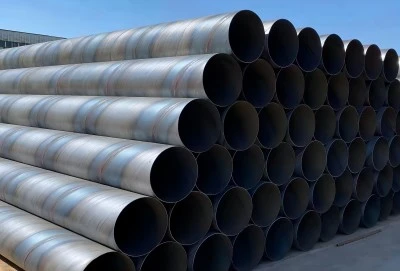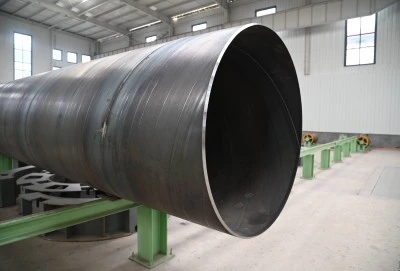Spiral welded pipe advantages:
Spiral welding pipe has gained significant popularity in various industries due to their unique manufacturing process and numerous advantages. These pipes are created by helically forming steel strips or plates into a tubular shape and welding the seam, resulting in a product that offers several benefits over traditional longitudinal welded pipes. This article explores the key advantages of spiral welded pipes, highlighting why they are increasingly preferred in many applications.
|
|
|
Production efficiency:
One of the primary advantages of spiral welding pipe is their highly efficient production process. The manufacturing of these pipes is continuous, which significantly improves production efficiency and reduces overall production costs. This continuous process is made possible by the helical forming of the steel strip, which allows for uninterrupted welding as the pipe is formed.
In traditional longitudinal welded pipe production, each pipe section requires individual forming and welding, often with breaks between processes. In contrast, the spiral welding process enables a constant feed of steel strip, forming, and welding in one seamless operation. This continuous production method not only increases the speed of manufacturing but also reduces labor costs and minimizes the potential for errors or inconsistencies that can occur during start-stop operations.
The efficiency of spiral welded pipe production also translates to energy savings. The continuous process requires less frequent heating and cooling cycles compared to batch production methods, leading to reduced energy consumption. Additionally, the streamlined production line often requires less factory floor space, potentially lowering overhead costs for manufacturers.
These production efficiencies ultimately result in cost savings that can be passed on to customers, making spiral welded pipes an economically attractive option for large-scale projects where cost management is crucial.
Size flexibility:
Another significant advantage of spiral welding pipe is their remarkable size flexibility. Using the same width of steel strip, manufacturers can produce pipes of different diameters simply by adjusting the forming angle. This versatility provides more size options for different applications without the need for extensive retooling or changes in raw material inventory.
The ability to produce various pipe diameters from a single steel strip width offers several benefits:
1. Reduced inventory costs: Manufacturers can maintain a smaller inventory of raw materials while still offering a wide range of pipe sizes.
2. Quick response to customer needs: Producers can swiftly adjust their production to meet specific customer requirements without significant delays.
3. Customization potential: The flexibility in sizing allows for easy customization of pipes for unique project specifications.
4. Optimization of material use: By adjusting the forming angle, manufacturers can minimize material waste when producing pipes of different diameters.
This size flexibility is particularly advantageous in projects that require pipes of varying diameters, as it allows for more efficient production scheduling and potentially faster delivery times. It also enables manufacturers to respond more effectively to market demands and changes in project specifications.
High strength:
Spiral welding pipe is known for their high strength, particularly in their ability to withstand higher pressures compared to straight seam welded pipes of similar specifications. This enhanced strength is primarily due to the nature of the spiral seam.
In spiral welded pipes, the weld seam follows a helical path around the pipe's circumference. This configuration distributes the stress more evenly across the pipe's surface compared to the longitudinal seam in straight welded pipes. As a result, the stress on the spiral weld is typically lower than that experienced by a straight seam under the same pressure conditions.
The lower stress on the weld seam contributes to several advantages: 1. Higher pressure ratings: Spiral welded pipes can often be used in higher pressure applications without increasing wall thickness. 2. Improved fatigue resistance: The more even stress distribution can lead to better performance under cyclic loading conditions. 3. Enhanced safety margins: The lower stress on the weld provides an additional safety factor in critical applications. 4. Potential for weight reduction: In some cases, the higher strength allows for the use of thinner-walled pipes, reducing overall weight without compromising performance.
These strength characteristics make spiral welded pipes particularly suitable for high-pressure pipelines, such as those used in the oil and gas industry, as well as in water transportation systems where reliability and safety are paramount.
Reduced material use:
One of the most significant economic and environmental advantages of spiral welding pipe is their potential for reduced material use. Under the same pressure conditions, the wall thickness of spiral welded steel pipes can often be 10% to 25% thinner than that of straight seam welded pipes while maintaining equivalent performance.
This reduction in wall thickness is possible due to several factors: 1. More even stress distribution: The spiral weld configuration allows for better stress distribution, reducing the need for additional material to manage localized stresses. 2. Improved weld quality: Advanced welding techniques used in spiral pipe production often result in stronger, more consistent welds, allowing for thinner walls without compromising integrity. 3. Optimized material properties: The spiral forming process can sometimes enhance the mechanical properties of the steel, potentially allowing for thinner walls while meeting strength requirements.
The ability to use thinner walls offers several benefits: 1. Material cost savings: Less steel is required to produce pipes of equivalent strength and performance. 2. Weight reduction: Lighter pipes are easier to transport and install, potentially reducing project costs. 3. Environmental impact: Reduced material use translates to lower energy consumption in steel production and transportation, contributing to a smaller carbon footprint. 4. Increased flow capacity: For a given outer diameter, thinner walls result in a larger internal diameter, potentially improving flow characteristics in fluid transportation applications.
These material savings can be substantial in large-scale projects, making spiral welded pipes an attractive option for cost-conscious and environmentally aware project managers.
Long pipe production:
A unique advantage of spiral welded pipes is their theoretical capability for indefinite length production. Unlike traditional pipe manufacturing methods that are limited by the length of steel plates or the constraints of production equipment, spiral welding allows for continuous pipe formation as long as the steel strip supply is maintained.
This capability for producing exceptionally long pipes offers several advantages:
1. Reduced cutting losses: Fewer cuts mean less material waste during production.
2. Improved material utilization: Longer pipes result in fewer joints in the final installation, potentially reducing material needed for connections.
3. Faster installation: Longer pipe sections can speed up the installation process, reducing labor costs and project timelines.
4. Fewer potential leak points: With fewer joints required, there are fewer potential points of failure or leakage in the pipeline system.
5. Cost savings in transportation: In some cases, longer pipes can be coiled for more efficient transportation, potentially reducing logistics costs.
While the practical length of spiral welded pipes is often limited by transportation and handling considerations, the ability to produce longer sections provides flexibility in project planning and execution. This can be particularly beneficial in offshore pipeline installations or in projects where minimizing field welding is crucial.
Spiral Welded Pipe Manufacturers:
Longma distinguishes itself in the market by offering customization options that allow clients to tailor products to their specific requirements. This customization extends to key specifications such as diameter, wall thickness, and material grade. By providing this level of flexibility, Longma ensures that clients can fully capitalize on the advantages of spiral welded pipes in their projects.
For those in the process of selecting a spiral welded pipe manufacturer for their projects, Longma invites inquiries and consultations. Their team of experts can provide detailed information about their products, customization options, and how their pipes can meet the specific requirements of various applications. Interested parties can reach out to Longma at info@longma-group.com to discuss their project needs and explore potential solutions.














